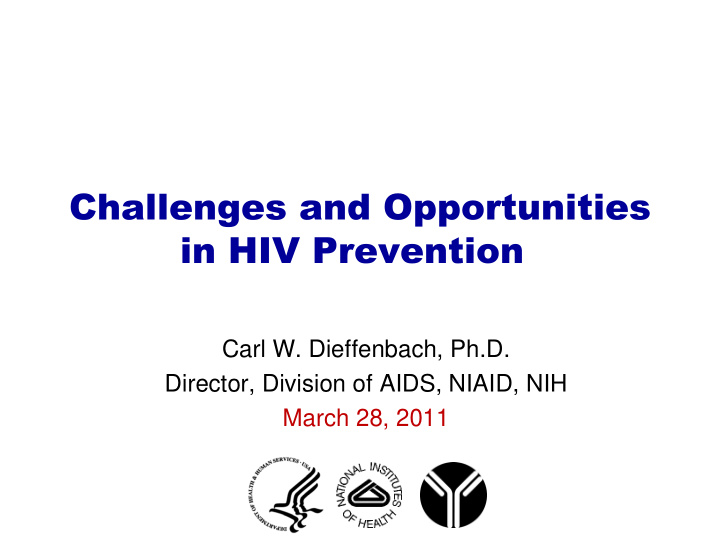



Challenges and Opportunities in HIV Prevention Carl W. Dieffenbach, Ph.D. Director, Division of AIDS, NIAID, NIH March 28, 2011
Know the Epidemic in the Community
� Reducing HIV incidence � Increasing access to care and optimizing health outcomes � Reducing HIV-related health disparities
Approaches to HIV Prevention Validated Approaches Research Needed • Clean syringes (i.e. needle • Topical microbicides exchange programs) • Pre-exposure prophylaxis • Condoms, and other barrier • Vaccines methods • Antiretroviral treatment as • Education and behavior prevention (Test and Treat) adaptation • Integrated combination • Treatment/prevention of prevention strategies drug/alcohol abuse • Interruption of mother-to- child transmission • Circumcision • HIV/STI Testing
Selected HIV Prevention Strategies Under Development ■ ARVs as Prevention – Microbicides – Pre-Exposure Prophylaxis (PrEP) – “Test and Treat” / TLC +
Next Steps
Topical Microbicides: Future Directions � Complete VOICE – move 1% Tenofovir gel to licensure � Expand efforts to develop rectal microbicides � Devise more acceptable, less behaviorally sensitive delivery methods � Explore combinations – Alternative microbicide strategies e.g., modulation of female reproductive tract (FRT) homeostasis – Vaccines and microbicides? � Evaluate novel clinical trial methodologies
PrEP Future Directions � Now that the concept is proven – complete VOICE! � Engage partners to define adherence strategies and approaches to social marketing � Develop and test combinations – pills and gels? � Devise means of incorporation of ARVs as prevention into combination packages
ART Reduces the Risk of Heterosexual HIV-1 Transmission in HIV-1 Sero-discordant African Couple Study (Abstract #136) Deborah Donnell, Fred Hutchinson Cancer Research Center ART in HIV ‐ Linked Person ‐ years of HIV infected partner Transmissions follow ‐ up Seroincidence Post ART 1 256 0.39 (95%CI 0.09 initiation to 2.18) No ART 102 4851 2.23 (95%CI 1.84 to 2.70)
E PIDEMIOLOGY AND P REVENTION HIV Transmission Risk Among Serodiscordant Couples: A Retrospective Study of Former Plasma Donors in Henan, China Lu Wang, MD, PhD,* Zeng Ge, BS,*† Jing Luo, BS,*‡ Duo Shan, BS,*† Xing Gao, MD, PhD,* Guo ‐ wei Ding, MD,* Jian ‐ ping Zhou, BS,§ Wen ‐ sheng He, BS,§ and Ning Wang, MD, PhD* C OMMENTARY HIV Treatment as Prevention: To be or not to be? Myron S. Cohen, MD “Second, and perhaps most important, transmission events occurred with equal frequency in couples regardless of whether the partner was provided free ART.” J Acquir Immune Defic Syndr Volume 55, Number 2, Oct. 1, 2010
100 HIV+ persons Objective Achieved Not Achieved 79% Not Virally Aware HIV+ 79 21 Suppressed Linked to care 47 32 53 60% Viral Load 26 21 74 suppressed 55% Overall: ~26% of HIV+ persons were in care and estimated to have a viral load <500 copies/ml
HPTN 065 update � HPTN 065 (TLC-Plus): A study to evaluate the feasibility of an enhanced test, link to care, plus treat approach for HIV prevention in the US – Study open to accrual: September 2010 – Enrolling: March 2011 – Anticipated results: 1Q 2014
Recommend
More recommend